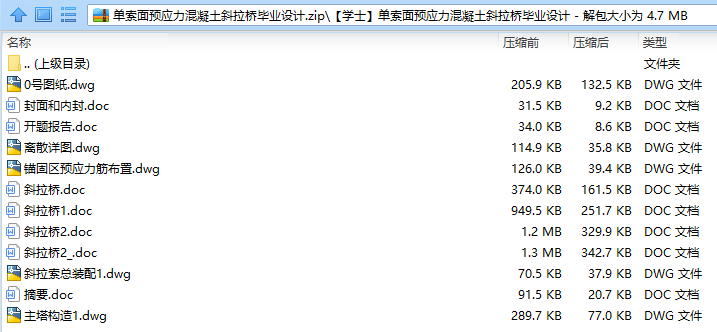摘要
近年来,由于高强钢材、正交异性板、焊接技术的发展及结构分析的进步,斜拉桥体系得到了广泛的应用。斜拉桥为空间结构,由加劲梁—钢或混凝土桥面板和支承部件—受压的桥塔与受拉的斜拉索组成,因其结构性能斜拉体系占据了梁桥和悬索桥的中间地位。
本设计为墩、塔、梁固结的单索面预应力混凝土斜拉桥,选择桥梁专用软件MIDAS来建模分析,计算该桥在自重、汽车、温度和支座沉降作用下的作用效应,并进行索塔的作用效应组合;但是,在自重作用下,成桥状态斜拉索的受力很不合理,故采用影响矩阵法对索力进行优化;再根据调整后的索力确定拉索的构造和下料长度;由于斜拉索水平分力的作用,索塔锚固区的混凝土会开裂,须在塔壁内配置闭合预应力筋。
关键词 斜拉桥;作用效应组合;索力优化;闭合预应力筋
Abstract
Wide and successful application of cable-stayed systems was realized only recently, with the introduction of high-strength steels, orthotropic type deck, development of welding techniques and progress in structural analysis. Cable-stayed bridges present a space system, consisting of stiffening girders as steel or concrete deck and supporting parts as towers acting in compression and inclined cables in tension. By their structural behavior cable-stayed systems occupy a middle position between the girder type and suspension type bridges.
The cable-stayed bridge is the single-plane and prestressed-concrete system,
whose pier, tower and girder are rigidly joined together. The design chooses the special software for bridge-MIDAS to create model and run structural analysis, get the effect in the action of dead load, live load, temperature and bearing subsidence, and then calculate the combination for action effects at the tower. But cable force caused by structural weight is very unreasonable, so the design optimize the cable force using the Influence Array method. Then in accordance with the accommodated cable force, the design portrays the configuration of the cables and calculates their construction length. In the action of the horizontal force, the concrete of the anchorage at the tower will crack, so the closed prestressed-steel bar must be laid in the tower.
Keywords cable-stayed bridge combination for action effects optimization of cable force closed prestressed-steel bar
目录
摘要.....................................................................................................................I
Abstract...............................................................................................................II
第1章 绪论..................................................................1
1.1 概述.........................................................1
1.1.1 结构体系...................................................1
1.1.2 主梁.............................................................2
1.1.3 索塔................................................................2
1.1.4 拉索.........................................................................................3
1.1.5 桥型确定.................................................................................3
1.2 目的与意义.......................................................................................3
2.1.1 立题目的.................................................................................3
2.1.2 立题意义.................................................................................4
1.3 主要内容..........................................................................................4
第2章 技术指标及设计资料...........................................................................5
2.1 设计依据..........................................................................................5
2.1.1 技术指标.................................................................................5
2.1.2 设计规范.................................................................................5
2.1.3 航运净空.................................................................................5
2.2 材料参数..........................................................................................5
2.2.1 混凝土.....................................................................................6
2.2.2 预应力钢材.............................................................................6
2.2.3 斜拉索.....................................................................................6
2.2.4 桥面铺装.................................................................................6
2.2.5 支座........................................................................................6
2.2.6 伸缩缝....................................................................................6
2.3 设计荷载与组合..............................................................................6
2.3.1 主要设计荷载.........................................................................6
2.3.2 索塔的作用效应组合.............................................................7
2.3.3 拉索的内力组合.....................................................................8
第3章 桥型与结构形式.................................................................................10
3.1 桥型总体布置................................................................................10
3.2 结构形式及尺寸............................................................................12
3.2.1 下部结构构造.......................................................................12
3.2.2 主塔......................................................................................12
3.2.3 斜拉索..................................................................................12
3.2.4 主梁......................................................................................13
第4章 结构整体分析....................................................................................14
4.1 计算原则.......................................................................................14
4.2 基本参数.......................................................................................14
4.2.1 截面性质..............................................................................14
4.2.2 设计荷载..............................................................................15
4.3 建模分析.......................................................................................16
4.3.1 结构计算简图......................................................................16
4.3.2 索力优化前内力及变形.......................................................17
第5章 成桥状态的索力优化........................................................................18
5.1 索力优化原理...............................................................................20
5.2 影响矩阵法优化索力...................................................................20
第6章 拉索设计...........................................................................................28
6.1 恒载索力.......................................................................................28
6.2 拉索构造.......................................................................................29
6.3 拉索下料长度...............................................................................30
6.4 索力验算.......................................................................................34
第7章 索塔锚固区受力分析......................................................................36
7.1 概述...............................................................................................36
7.2 锚固区受力...................................................................................36
7.3 计算分析.......................................................................................38
7.4 预应力筋的估算...........................................................................42
7.4.1 预应力损失..........................................................................42
7.4.2 预应力筋的估算原则..........................................................44
7.4.3 预应力筋布置......................................................................45
7.4.4 估算预应力筋......................................................................45
7.5 有效预应力...................................................................................46
7.6 承载能力极限状态验算...............................................................49
7.6.1 计算原则.............................................................................49
7.6.2 预应力次效应......................................................................50
7.6.3 正截面抗弯承载力计算.......................................................51
7.7 斜截面抗剪承载力.......................................................................55
7.8 持久状况正常使用极限状态计算................................................55
7.9 持久状况应力计算.......................................................................58
结论..................................................................................................................61
致谢..................................................................................................................62
参考文献..........................................................................................................63
附录1...............................................................................................................64
附录2...............................................................................................................66




